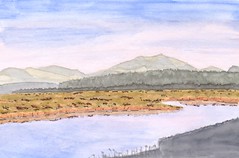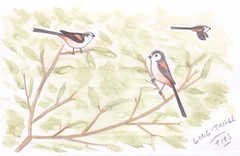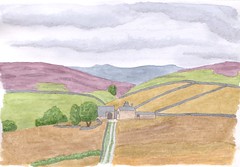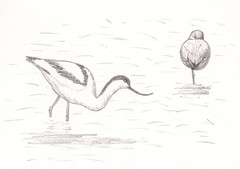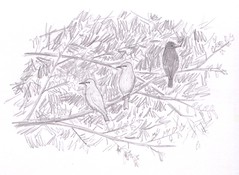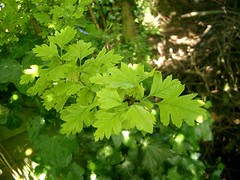We’ve just got back from our holiday. We went to Anglesey and stayed in a cottage overlooking the sea, at Porth Nobla, just outside Rhosneigr. It was a naturalists’ dream, certainly ours’.
At the front of the house was a beach, flanked with rocks. There must have been a dozen species of seaweed of all shades of green, brown and red. It was swarming with crabs the size of your thumbnail. There was the usual assortment of waders, gulls and wagtails, plus the odd heron or two, and on calm high tides grey seals popped their heads out.
At the back was scrub and farmland, with buzzards and kestrels often in view. One morning I even saw two buzzards flying over the beach, from my bed – I shall have to start a ‘bed list’. Ravens were feeding in the sheep paddocks, and in these days of falling starling numbers, it was good to see around two hundred sat on the telephone wires. In the evenings, four to five hundred greylag geese could be spectacularly seen and heard coming in to roost on the nearby lakes.
A moving part of the holiday for me, was to visit Shorelands at Malltraeth, the home of the late artist, Charles Tunnicliffe. For those of you that don’t know, he was the original illustrator of ‘Tarka the Otter’, and he also illustrated the ‘Dig for Victory’ campaign posters and lots of the nature ladybird books, but his first love was birds. I felt privileged to see where he lived and painted, it has the most amazing view overlooking the Cefni estuary. Equally impressive are his original paintings at Oriel Ynys Mon, the museum built principally, I suspect, to house Tunnicliffe’s work, despite a local campaign in the late 80’s to prevent what was then seen as a waste of municipal money. Anyway, the museum is more than that now, housing displays reflecting all aspects of Anglesey life. Tunnicliffe’s art is breathtaking, all the more so as he never intended it to be displayed, it was done for pure pleasure. I hope the campaigners now see its’ worth.
Follow the link to see my Anglesey Sketchbook.
Monday, August 29, 2005
Saturday, August 20, 2005
Long-tailed Tits
Behind our house there is a large brick yard, where they make and dispatch bricks and blocks of all kinds. This has several down sides, such as the dust, the large number of lorries that go past the end of the street, occasional rats and the low level, but almost constant, industrial hum. The local residents' association keep them in check.
However, there is an upside. The site is surrounded by mature trees and hedgerows, and at our end their is a small area of scrub and low woodland. The birds and insects love it.
I try to go along the footpath between the back of the house and this area regularly, just to see what's about. I have to be careful not to loiter so I don't look like a peeping tom. Nathan helps me here, when he's with me I look much less suspicious.
We walked past during the week and were treated to a flitting fly-past by a family party of long-tailed tits. These are one of Deb's favourite birds, and I can see why. They're like a fluffy pom-pom on a lolly stick of a tail, and their contact calls can only be described as a purr. I only wish we saw them in the garden more often.
However, there is an upside. The site is surrounded by mature trees and hedgerows, and at our end their is a small area of scrub and low woodland. The birds and insects love it.
I try to go along the footpath between the back of the house and this area regularly, just to see what's about. I have to be careful not to loiter so I don't look like a peeping tom. Nathan helps me here, when he's with me I look much less suspicious.
We walked past during the week and were treated to a flitting fly-past by a family party of long-tailed tits. These are one of Deb's favourite birds, and I can see why. They're like a fluffy pom-pom on a lolly stick of a tail, and their contact calls can only be described as a purr. I only wish we saw them in the garden more often.
Friday, August 12, 2005
Dark Peak
You can see the northern edge of the Peak District, Britain’s first national park, from just about any high point in Leeds. I see it every day on the way to or from home and it’s been calling me for the last few weeks. So yesterday, I went up onto the moors of the Dark Peak, or the northern half of the Peak District.
The Dark Peak is predominantly acidic peat moorland overlying gritstone, which pokes out to form rocky outcrops. The dominant plant is heather. This is particularly impressive about now, colouring whole hillsides a purplish hue and doing so on a huge scale. Otherwise, the only obvious sign of life is the red grouse, constantly calling ‘go-back, go-back’, with the occasional ‘seep’ of a meadow pipit. On an overcast day like today, with a blustery wind, this is an evocative place.
After doing some sketching, I drove down into the wooded valleys and ate my dinner at Fairholmes, overlooking Ladybower reservoir. With tits on the birdfeeders, nuthatches calling in the trees, tame ducks taking crusts and walkers and cyclists setting off/coming back, it was pleasantly busy (and warm) by comparison with the moor tops.
(I even made it home in time to see Shane Warne take his 600th test wicket.)
The Dark Peak is predominantly acidic peat moorland overlying gritstone, which pokes out to form rocky outcrops. The dominant plant is heather. This is particularly impressive about now, colouring whole hillsides a purplish hue and doing so on a huge scale. Otherwise, the only obvious sign of life is the red grouse, constantly calling ‘go-back, go-back’, with the occasional ‘seep’ of a meadow pipit. On an overcast day like today, with a blustery wind, this is an evocative place.
After doing some sketching, I drove down into the wooded valleys and ate my dinner at Fairholmes, overlooking Ladybower reservoir. With tits on the birdfeeders, nuthatches calling in the trees, tame ducks taking crusts and walkers and cyclists setting off/coming back, it was pleasantly busy (and warm) by comparison with the moor tops.
(I even made it home in time to see Shane Warne take his 600th test wicket.)
Thursday, August 04, 2005
Blacktoft Sands
Today I spent the day at one of my favourite places, the RSPB’s reserve at Blacktoft Sands. The great thing about this reserve is that it’s not ‘in your face’, there’s plenty of comfortable hides in easy walking distance, there’s no ‘experience’ being rammed down your throat but there is info available if you want it. Blacktoft does get some ‘twitchers’ birds’ but on the whole it’s a breeding ground and a spot for migrants to rest and refuel, a place to see plenty of wetland birds very well. Anyway, it was peaceful and warm, just the job for doing some drawing and for simply being close to nature.
There were all the birds you’d expect to see here, dunlin, ruff, redshank, greenshank, lapwing, plus a few Blacktoft specialities, avocet (of RSPB logo fame), bearded tit and spotted redshank, but no marsh harrier – maybe a bit windy for them today. There was the added bonus of a spoonbill, unusual enough, however this bird had been ringed (i.e. had plastic identification rings put on its legs) as a chick in Holland two years ago, so a bit of life history to add interest.
I was glad of a few years of birding experience to identify the many wading birds present. Present in all stages of plumage, summer, winter, adult, juvenile, and all points in between. So I felt for a mum with her 3 children, trying to identify the birds when she couldn’t even understand the order used in her field guide (divers, grebes, shearwaters, etc.) – a free gift for new members of the RSPB! You do learn the crazy taxonomic order over the years, but it doesn’t exactly encourage newcomers or the young. In future, I’ll be far less scornful of field guides ordered by size, colour or habitat.
Click on the link the see the other sketches I did today – Blacktoft Sands Sketchbook.
There were all the birds you’d expect to see here, dunlin, ruff, redshank, greenshank, lapwing, plus a few Blacktoft specialities, avocet (of RSPB logo fame), bearded tit and spotted redshank, but no marsh harrier – maybe a bit windy for them today. There was the added bonus of a spoonbill, unusual enough, however this bird had been ringed (i.e. had plastic identification rings put on its legs) as a chick in Holland two years ago, so a bit of life history to add interest.
I was glad of a few years of birding experience to identify the many wading birds present. Present in all stages of plumage, summer, winter, adult, juvenile, and all points in between. So I felt for a mum with her 3 children, trying to identify the birds when she couldn’t even understand the order used in her field guide (divers, grebes, shearwaters, etc.) – a free gift for new members of the RSPB! You do learn the crazy taxonomic order over the years, but it doesn’t exactly encourage newcomers or the young. In future, I’ll be far less scornful of field guides ordered by size, colour or habitat.
Click on the link the see the other sketches I did today – Blacktoft Sands Sketchbook.
Monday, August 01, 2005
Starlings
I sat on the bench under the hawthorn, this afternoon. Half a dozen or so starlings, adults and juveniles, sat above, quietly clicking and whistling, nothing too raucous. Lovely.
Subscribe to:
Posts (Atom)

